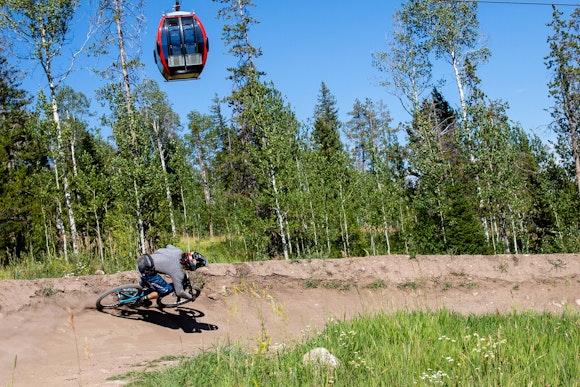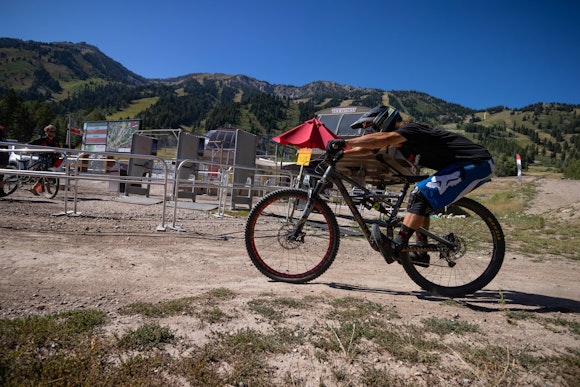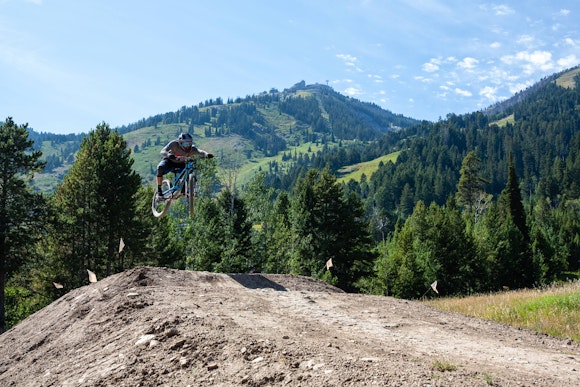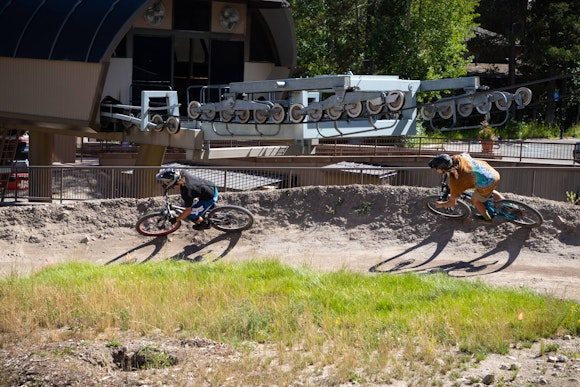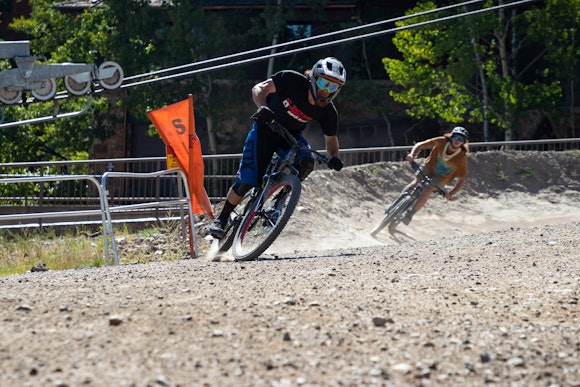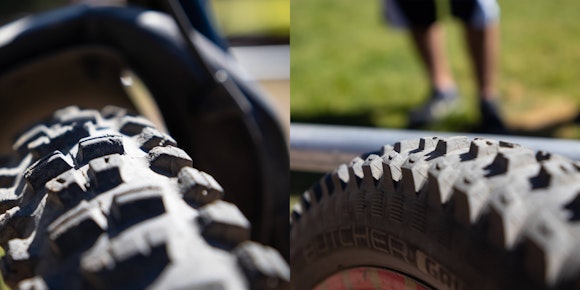Howdy, mountain bikers!
I’m Brian Selmer. Jackson Hole Bike Park employee and winner of this summer’s chain-less downhill series. I’ve built bike trails at the JH Bike Park for a couple of years now and can’t get enough mountain biking when the snow isn’t flying. The following is my top 5 tips and tricks that will help you go bigger, have more fun, and ride harder in the bike park. I hope you learn something new!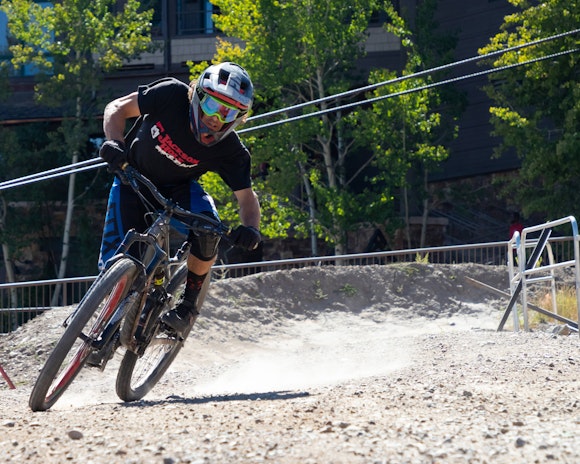
Body Position
A great mantra to repeat to yourself is “Heavy feet, light hands”. Don’t rest your weight on your arms. Keep your feet level on the pedals, stand up, and square your shoulders. Your bike was designed to be balanced in this position. Think about pointing your chest through turns, or aiming your hips, whatever mental game works for you. Make sure to look through turns, and keep your head up! Don’t get caught looking at your front tire, but be scanning as far ahead as possible. Relax your limbs a bit, and let them jostle with the bike. Biking is a dance with the trail, acting heavy one moment and weightless the next, looking through turns and anticipating the horizon. Whether you are crouched or extended, and how fast you can change between the two positions are the building blocks of trail riding. Avoid having stiff legs- they are the best shock absorber in your quiver.
Some common position pitfalls: Squeezing the grips too hard will make your hands numb quickly. Remember- Heavy feet, light hands.
You will go where you are looking, so look at smooth lines. Try not to stare right at that huge rock in the way.
— NEVER sit down! — Sitting sets you up to get bucked on bumps, and wash out your turns. I guess you can sit down if you’re climbing a trail.
Braking
First things first, basic safety. NEVER use more than one finger per hand to brake. You need to hold onto the bike with all available fingers, and brakes are super strong nowadays.
Fact: The fastest way to slow down is a straight line. Another fact: It turns out, 70%-95% of your stopping power is in your front tire. Applying these to the trail, you must brake before turns, in a straight line, in as smooth of a spot as possible. Picture your weight getting pitched forward when you hit the brakes. Compensate for this by getting super low and leaning back. Dig in those heels, it drops your weight even more! Once you have slowed down in a straight line, let off the brakes and lean into the turn, one smooth motion.
Avoid braking in rough terrain, for a tire on the brakes is asking to become flat; if it loses its ability to roll over objects, it just smashes into them. Your whole bike will thank you if you can avoid the temptation to brake when the going gets rough. Your nice comfortable super-suspension only works when you are OFF the brakes. Treat rough zones like turns, and get your braking done before them. Certain sections of trail can be treated as absolute “No Front Brake Zones”. (Steep, wet, roots, rocks, eg.) Come in extra slow to these sections, because that is your last chance to slow down.
Jumping
To simplify things a bit, let’s consider 2 ways of jumping. The goal is to land in the sweet spot of the landing, right after the knuckle. You can come in with less speed and pop, or go faster and absorb a jump. Keep in mind, if you pop and lock, this leaves you in an extended body position, straight-legged, just waiting to hit the ground. This also leaves you prone to sailing off with a wind gust. Hit a jump with more speed, and you can absorb it. This brings the bike up close to you, and then you can place the bike down when you want to. Being passive while hitting a jump lets the jump decide what happens in the air. Make sure that you, not the jump, are the one controlling and initiating what happens right before take-off.
Always square your body before hitting a jump; pedaling too close to a jump is asking to get thrown sideways, off-balance. Knowing the speed needed for a jump is dangerous to figure out. To safely navigate this learning curve, watch or follow a friend who knows the trail to get a feel for the speed. Roll or go around a jump at first. Oftentimes, the key to unlocking a jump is to figure out the fastest way to hit the turn beforehand. Jump trails are like tests. You can skip questions and not get docked, but a wrong answer will cost you. Take baby steps and use repetition until you have the whole trail memorized. Remember that the trail will still be there tomorrow… Conditions can change day to day as well; you will find that a wet trail is slower than a dry one, and wind can really affect your speed.
Turning (2 Types)
Berm Turns:
The name of this game is getting in early. Enter berms as wide as possible, setting up for a left berm turn on the right side of the trail, maximizing berm-time. This helps you in several ways: The banked surface of the berm cradles you through the turn, allowing way more speed than a flat turn could. Also, this surface is the cleanest part of the trail. Trying to shorten your line might seem faster at first, but it will put you into the piles of rock and dust that can gather under the berm.
Consider your exit speed. If you can get your body position low entering turns, and stand up in the right spot, you can milk speed out of it. This is called “Pumping Transition”. Spring up through the apex of your curve and load the scales with as much weight as possible. Not only do you get a little speed, but your tire is being pushed into the ground with a force many times your normal body weight. MEGA GRIP!
Flat Turns:
If there aren’t any rocks for your pedals to hit, drop your outside foot, and push your inside handlebar down. Leaning your bike this way lets you utilize your tire’s side knobs. Open up your hips into the turn with your outside foot down. You are now carving! This position lets your bike lean waayyy over. I try to keep more weight on the front tire in flat turns, so if any tire loses traction, it will be the rear. Putting your inside foot out towards the front wheel like a motocross turn works well, and you can put a foot down if you lose traction.
Tires
Tires are all about trade-offs. Do you want the ultimate traction? Prepare to roll slowly everywhere… Do you want the lightest tires ever? They get flats very easy… Do you want wagon wheels that can run over anything in their path? They might be hard to flick around… Slow and grippy, or nimble and slippery, tire choice is surprisingly important. With so many options, it is hard to know what exactly to choose. Tubes or tubeless? I used to use inner-tubes, but had to run high pressures to prevent flats. I pin-balled off rocks, instead of tracking over them. But, it was light. Now, I run tubeless tires with Cushcore installed to reduce impact damage by 50%, also keeping the tires on the rim like bead-lockers. I can run way less tire pressure, and mostly said goodbye to flats, but will curse changing a tire. It is messy and adds half a pound to each tire.
Look at the tread of the tires. How much edge does it have for slowing down? How much for turning? Are the knobs close together, or are they spaced for penetration? How tall are the knobs, and what kind of rubber are they made from? Some tires work really good in very specific environments. Do they incentivize keeping the bike in the grass like a soccer cleat, or have an uber grip on hardpack? Super-tacky tires are very soft for the ultimate race traction, but get chewed up after a couple of runs. What about the sidewall? Is it a slow-rolling DH casing tire, sidewall abuse ready, or an x-c tire built to climb hills?
If you are wondering what tires to try out, the standard by which all other mountain bike tires are measured is the Maxxis Minion. It comes in a front DHF and rear DHR model and is a great place to start out These are great time-proven treads and rubber. Your bike is only as good as what hits the ground, so I would consider tires the most important, and easiest to change, aspect of your ride.
If you have made it this far, congratulations!
I hope I haven’t bored the heck right outta ya.
Happy Trails!
-Brian Selmer
Bike Park
Interested in lapping the Jackson Hole Bike Park? Learn more about our trail system here!
